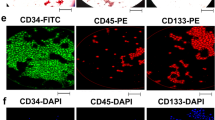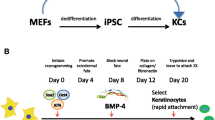Abstract
Human embryonic stem cells (hESCs) can differentiate into all somatic lineages including stratified squamous epithelia. Thus, efficient methods are required to direct hESC differentiation to obtain a pure subpopulation for tissue engineering. The study aimed to assess the effects of retinoic acid (RA), bone morphogenetic protein-4 (BMP4), and ascorbic acid (AA) on the differentiation of hESCs into keratinocyte progenitors in vitro. The first media contained AA and BMP4; the second contained RA, AA, and BMP4; the third was commercial-defined keratinocyte serum-free medium, which was used to differentiate H9 hESCs (direct approach) or embryoid bodies (EBs) (indirect approach) into keratinocyte progenitors. Real-time RT-PCR, immunofluorescence, and flow-cytometry were used to characterize the differentiated cells. Cells induced by AA + BMP4 + RA showed the typical epithelial morphology, while cells induced by AA + BMP4 showed multiple appearances. CK14 and p63 messenger RNA (mRNA) expressions in the AA + BMP4 + RA-treated cells were higher than those of the AA + BMP4-treated cells (CK14: 22.4-fold; p63: 84.7-fold). Epithelial marker CK18 mRNA expressions at 14 d of differentiation and keratinocyte marker CK14 and transcription factor p63 mRNA expressions at 35 d of differentiation were higher in cells differentiated from hESCs compared with those differentiated from EBs (CK18 10.51 ± 3.26 vs. 6.67 ± 1.28; CK14 9.27 ± 3.61 vs. 5.32 ± 1.86; p63 0.73 ± 0.06 vs. 0.44 ± 0.12, all P < 0.05) After hESC induction by AA+BMP4+RA, CK14 mRNA expression was upregulated after day 21, peaking by 35 d of differentiation. Combined RA, BMP4, and AA could effectively induce differentiation of hESCs into keratinocyte progenitors in vitro. These keratinocytes could be used for oral mucosa and skin tissue engineering.






Similar content being viewed by others
References
Barlow Y, Pye RJ (1997) Keratinocyte culture. Methods Mol Biol 75:117–129. doi:10.1385/0-89603-441-0:117
Blomme EA, Weckmann MT, Capen CC, Rosol TJ (1998) Influence of extracellular matrix macromolecules on normal human keratinocyte phenotype and parathyroid hormone-related protein secretion and expression in vitro. Exp Cell Res 238:204–215. doi:10.1006/excr.1997.3830
Catani MV, Savini I, Rossi A, Melino G, Avigliano L (2005) Biological role of vitamin C in keratinocytes. Nutr Rev 63:81–90
Chen SS, Revoltella RP, Papini S, Michelini M, Fitzgerald W, Zimmerberg J, Margolis L (2003) Multilineage differentiation of rhesus monkey embryonic stem cells in three-dimensional culture systems. Stem Cells 21:281–295. doi:10.1634/stemcells.21-3-281
Claudinot S, Nicolas M, Oshima H, Rochat A, Barrandon Y (2005) Long-term renewal of hair follicles from clonogenic multipotent stem cells. Proc Natl Acad Sci U S A 102:14677–14682. doi:10.1073/pnas.0507250102
Dawson RA, Goberdhan NJ, Freedlander E, MacNeil S (1996) Influence of extracellular matrix proteins on human keratinocyte attachment, proliferation and transfer to a dermal wound model. Burns 22:93–100
De Luca M et al (1989) Multicentre experience in the treatment of burns with autologous and allogenic cultured epithelium, fresh or preserved in a frozen state. Burns 15:303–309
Dickson MA et al (2000) Human keratinocytes that express hTERT and also bypass a p16(INK4a)-enforced mechanism that limits life span become immortal yet retain normal growth and differentiation characteristics. Mol Cell Biol 20:1436–1447
Gambaro K, Aberdam E, Virolle T, Aberdam D, Rouleau M (2006) BMP-4 induces a Smad-dependent apoptotic cell death of mouse embryonic stem cell-derived neural precursors. Cell Death Differ 13:1075–1087. doi:10.1038/sj.cdd.4401799
Green H, Easley K, Iuchi S (2003) Marker succession during the development of keratinocytes from cultured human embryonic stem cells. Proc Natl Acad Sci U S A 100:15625–15630. doi:10.1073/pnas.0307226100
Guenou H et al (2009) Human embryonic stem-cell derivatives for full reconstruction of the pluristratified epidermis: a preclinical study. Lancet 374:1745–1753. doi:10.1016/S0140-6736(09)61496-3
Iuchi S, Dabelsteen S, Easley K, Rheinwald JG, Green H (2006) Immortalized keratinocyte lines derived from human embryonic stem cells. Proc Natl Acad Sci U S A 103:1792–1797. doi:10.1073/pnas.0510953103
Ji L, Allen-Hoffmann BL, de Pablo JJ, Palecek SP (2006) Generation and differentiation of human embryonic stem cell-derived keratinocyte precursors. Tissue Eng 12:665–679. doi:10.1089/ten.2006.12.665
Kidwai FK, Cao T, Lu K (2014) Differentiation of epidermal keratinocytes from human embryonic stem cells. Methods Mol Biol 1195:13–22. doi:10.1007/7651_2013_46
Kidwai FK et al (2013) Differentiation of human embryonic stem cells into clinically amenable keratinocytes in an autogenic environment. J Invest Dermatol 133:618–628. doi:10.1038/jid.2012.384
Li XJ, Du ZW, Zarnowska ED, Pankratz M, Hansen LO, Pearce RA, Zhang SC (2005) Specification of motoneurons from human embryonic stem cells. Nat Biotechnol 23:215–221. doi:10.1038/nbt1063
Metallo CM, Ji L, de Pablo JJ, Palecek SP (2008) Retinoic acid and bone morphogenetic protein signaling synergize to efficiently direct epithelial differentiation of human embryonic stem cells. Stem Cells 26:372–380. doi:10.1634/stemcells.2007-0501
Metallo CM, Ji L, de Pablo JJ, Palecek SP (2010) Directed differentiation of human embryonic stem cells to epidermal progenitors. Methods Mol Biol 585:83–92. doi:10.1007/978-1-60761-380-0_7
Papini S et al (2003) Isolation and clonal analysis of human epidermal keratinocyte stem cells in long-term culture. Stem Cells 21:481–494. doi:10.1634/stemcells.21-4-481
Reubinoff BE, Pera MF, Fong CY, Trounson A, Bongso A (2000) Embryonic stem cell lines from human blastocysts: somatic differentiation in vitro. Nat Biotechnol 18:399–404. doi:10.1038/74447
Romagnoli G, De Luca M, Faranda F, Bandelloni R, Franzi AT, Cataliotti F, Cancedda R (1990) Treatment of posterior hypospadias by the autologous graft of cultured urethral epithelium. N Engl J Med 323:527–530. doi:10.1056/NEJM199008233230806
Savini I, Catani MV, Rossi A, Duranti G, Melino G, Avigliano L (2002) Characterization of keratinocyte differentiation induced by ascorbic acid: protein kinase C involvement and vitamin C homeostasis. J Invest Dermatol 118:372–379. doi:10.1046/j.0022-202x.2001.01624.x
Schuldiner M, Yanuka O, Itskovitz-Eldor J, Melton DA, Benvenisty N (2000) Effects of eight growth factors on the differentiation of cells derived from human embryonic stem cells. Proc Natl Acad Sci U S A 97:11307–11312. doi:10.1073/pnas.97.21.11307
Stottmann RW, Berrong M, Matta K, Choi M, Klingensmith J (2006) The BMP antagonist Noggin promotes cranial and spinal neurulation by distinct mechanisms. Dev Biol 295:647–663. doi:10.1016/j.ydbio.2006.03.051
Thomson JA, Itskovitz-Eldor J, Shapiro SS, Waknitz MA, Swiergiel JJ, Marshall VS, Jones JM (1998) Embryonic stem cell lines derived from human blastocysts. Science 282:1145–1147
Wong DJ, Chang HY (2008) Skin tissue engineering. In: StemBook. Cambridge (MA)
Acknowledgments
We would like to thank Cao Tong (Department of Oral and Maxillofacial Surgery, Faculty of Dentistry, National University of Singapore) and Xiao Ran and Fu Xin (Research Center of Plastic Surgery, Plastic Surgery Hospital, Chinese Academy of Medical Sciences). This research was supported by the National Natural Science Foundation of China (Grant No. 81170968).
Author information
Authors and Affiliations
Corresponding author
Ethics declarations
Conflict of interest
The authors declare that they have no conflict of interests.
Additional information
Editor: Tetsuji Okamoto
Rights and permissions
About this article
Cite this article
Li, H., Zhou, H., Fu, X. et al. Directed differentiation of human embryonic stem cells into keratinocyte progenitors in vitro: an attempt with promise of clinical use. In Vitro Cell.Dev.Biol.-Animal 52, 885–893 (2016). https://doi.org/10.1007/s11626-016-0024-2
Received:
Accepted:
Published:
Issue Date:
DOI: https://doi.org/10.1007/s11626-016-0024-2




